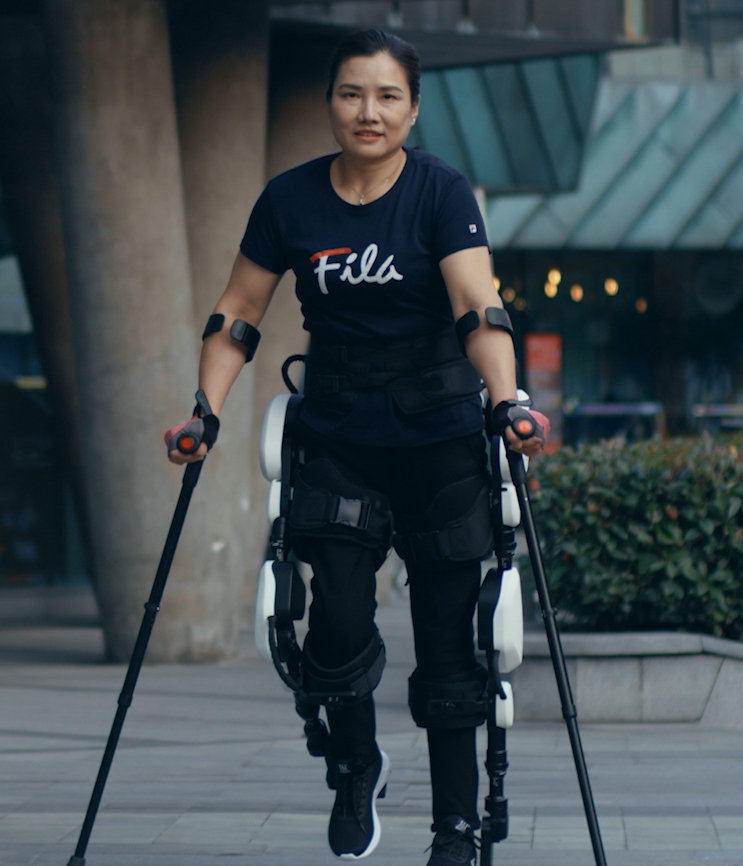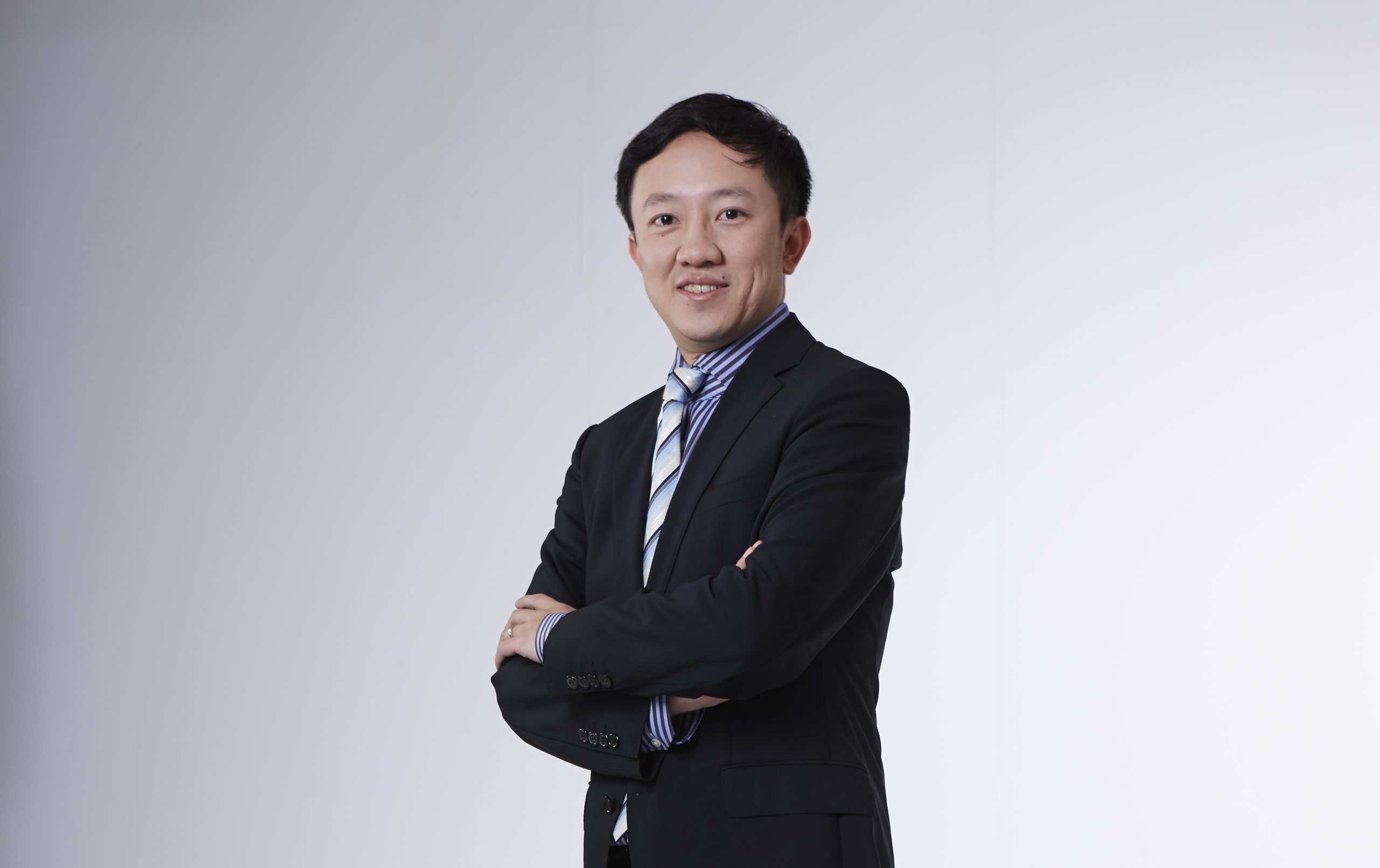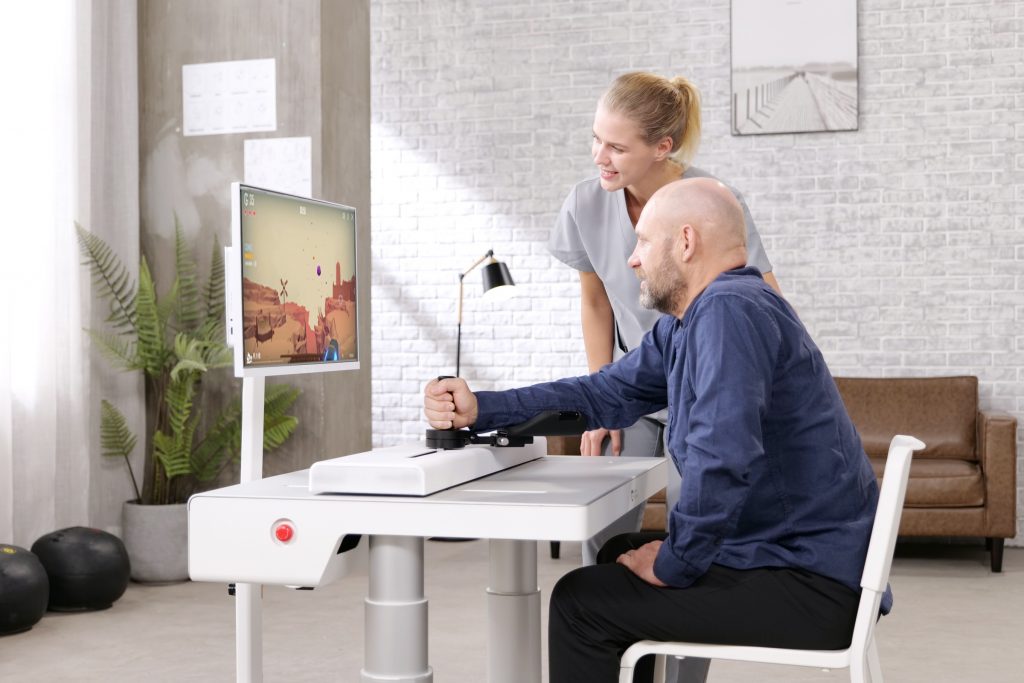For the paralyzed, standing on their own feet to walk again seems like a far-off dream, with many injuries involving the nervous system being permanent. However, recent updates in innovative robotics technologies can help make this dream a reality.
Yao Fang, a Chinese wheelchair fencing gold medalist in the London 2012 Paralympic Games, regained partial mobility with the help of a wearable robot designed and manufactured by Shanghai Fourier Intelligence. Born in 1972, Yao was badly injured in a car accident in 1998 when she was 26, forcing her to accept life in a wheelchair before the arrival of this specialized robot more than 20 years later.
The device, which weighs 18 kg, allows Yao to leave her wheelchair temporarily to walk, so she can visit places like parks or supermarkets. It uses a bracing mechanism for the back and legs, coupled with forearm crutches.
However, robot-enabled prostheses, or exoskeletons, are still costly. While the technology cannot yet replicate natural human movement, the industry is progressing rapidly, giving hope to people with neurological disabilities and spinal cord injuries.
KrASIA spoke with Fourier Intelligence’s founder and CEO Gu Jie, also known as Alex Gu, about how such robots are developed and marketed.

The push for China-made robots
Fourier Intelligence, founded in 2015, took its name from French mathematician and physicist Joseph Fourier. The firm is a latecomer in the robotics industry, which first started to take off in the 1960s in the United States for industrial use. The startup is also a relatively new player in the rehabilitation robotics segment, compared to other competitors such as ReWalk Robotics, set up in Israel in 2001, and Cyberdyne, founded in Japan in 2004.
The robot that Yao uses is one of Fourier’s latest devices, the ExoMotus X2 Lower Extremity Exoskeleton. With sensors fitted on the thighs, knees, and feet, X2’s control system detects the tilt of the user’s upper body and generates force via motors equipped at the joints of the hip and knees to move the users’ legs.
Both the sensors and motors used in the X2 are developed in-house by Fourier. The technology behind the X2 falls into a list of key parts stipulated by China’s Ministry of Industry and Information Technology (MIIT), as part of the country’s robotics industry development plan from 2016 to 2020, which calls for more Chinese-made surgical and rehabilitative devices.
To nurture the country’s entire robotics industry, MIIT would introduce preferential tax policies, establish national-level standards, and develop talent in universities.
When the government initiative was rolled out in May of 2016, Fourier was still in its infancy without a single marketable product. However, three years later, Xin Guobin, vice-minister of MIIT, called the firm a model for the medical robotics sector and of Chinese robotics research and application during his speech at the World Robot Conference in Beijing in August 2019.
“We are not producing replacements to overseas products as some of our technologies, such as the force control, are even more advanced than our peers’,” said Gu. “This is why our products have been exported to 20 countries.”
In addition to the X2, which helps patients regain mobility in their lower limbs, Fourier has also rolled out other skeletons for patients recovering from a variety of injuries. Their products include the ArmMotus, for arm rehabilitation, WristMotus for wrists, and AnkleMotus for ankles. For example, the ArmMotus can serve as a physical therapist’s hand to guide a patient during rehab exercises, Gu explained.
“It is not like a lifeless robotic arm which can just move things inside an industrial plant. It helps patients do therapeutic training with man-machine interaction via force feedback,” Gu said.

Making Exoskeletons affordable
“Out of five Chinese people, only one has heard of rehab services from therapists, not to mention rehab robotics,” said Gu.
Fourier found its first clients in research institutions, hospitals, and rehab centers. These include the US-based Barrow Neurological Institute, the University of Melbourne, and Switzerland’s polytechnic ETH Zurich. Local clients include Ruijin Hospital, affiliated with Shanghai Jiaotong University, and Huashan Hospital, which is affiliated with Fudan University.
As Fourier designs key components in-house and manufactures the final products in China, the company’s robots are less expensive than similar products made overseas, Gu explained.
For example, one version of the X2 robot with open software platform to facilitate researchers’ future development starts at around RMB 800,000 (USD 113,000), while another version of this robot without such a platform is priced between RMB 300,000 and RMB 500,000 ((USD 42,000 to USD 70,000), according to the founder. Competitors such as Swiss company Hocoma’s robot price similar products for as much as EUR 330,000 (USD 362,000), according to a research report, which gives Gu’s company a competitive advantage.
The company now plans to roll out a new version of its robots for personal use in August or September of this year, promising affordable prices for the individuals, compared to robots priced between USD 69,500 and USD 85,000 by Israel-based ReWalk, or Cyberdyne products, which start at USD 150,000, according to a Chinese report.
Niu Chuanxin, who leads a rehab research lab inside Ruijin Hospital, told KrASIA that Fourier’s products were first used in his team’s research and started to serve patients as of March 2018 after obtaining sales licenses from government agencies.
The ArmMotus robot, which was formerly known as M2, was the first robot to enter Ruijin Hospital. “With these robots, one therapist could coordinate therapy sessions with a group of patients, with each robot aiding one patient, as opposed to one-on-one rehab,” Niu said.
Fourier’s CEO explained that after patients familiarize themselves with these robot-enabled prostheses in hospitals and rehabilitation centers, people want to have them at home. “We can customize products for them depending on their unique demands,” he added.

Increased demand during the COVID-19 pandemic
China’s MIIT set an expectation of RMB 30 billion (USD 4.2 billion) for the entirety of the domestic service robotics market in its 2016 to 2020 plan, paling in comparison to Gu’s valuation, who mentioned to KrASIA that the current local market for rehab robots is worth around RMB 50 billion (USD 7 billion), growing at an annual rate of 20%.
On the other hand, the Chinese Institute of Electronics predicted in August 2019 that the country’s service robot market will reach USD 2.2 billion by the end of the year, still shy of Gu’s estimate, while US-based research firm Fortune Business Insights expects the global rehab robot market to grow from USD 529.8 million in 2018 to USD 2.6 billion by 2026, according to a report published in 2019.
Still, Fortune Business’ report “does not consider the impact of the COVID-19 pandemic on the market,” a sales representative of the firm told KrASIA via email, adding that the company would update the report taking into consideration the effects of the pandemic on the sector.
According to Gu, the pandemic has had almost no negative impact on the company’s operations, but instead, has actually increased demand for rehab services and products.
Despite more conservative estimates on the current market value, as an entrepreneur in the midst of the industry, Gu believes that the future is bright and “there is no ceiling for the rehab robots market”. According to him, they can be used to help the elderly, the disabled, and many others.
Like Gu, Ruijin Hospital’s Niu Chuanxin also confirmed the importance of robotics in the development of rehab services, referring to them as “weapons that doctors can use to fight against diseases”. He added that such tools are currently far from sufficient to meet the demand, welcoming more support and innovation from the corporate sector.
Backing Gu’s bullishness on the market’s future prospects, investors seem eager to bet on this field.
Fourier completed a Series B+ funding round in May, collecting tens of millions of yuan from Qianhai Fund of Funds, a Shenzhen-based equity financing firm. Combining this round and the Series B round closed in July 2019, the startup has bagged nearly RMB 100 million (USD 14 million) so far, KrASIA reported.
Gu, who has predicted his company to break even this year, has greater ambitions for his business than financial achievements.
“We do not want to build our company as a local Chinese company. We are willing to connect with laboratories, technologies, and suppliers worldwide to help patients regain mobility.”
This article is part of KrASIA’s “Inside China’s Startups” series, where the writers of KrASIA speak with founders of tech companies in the country
